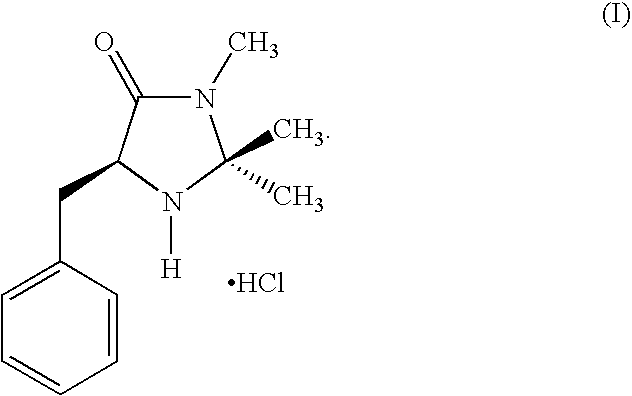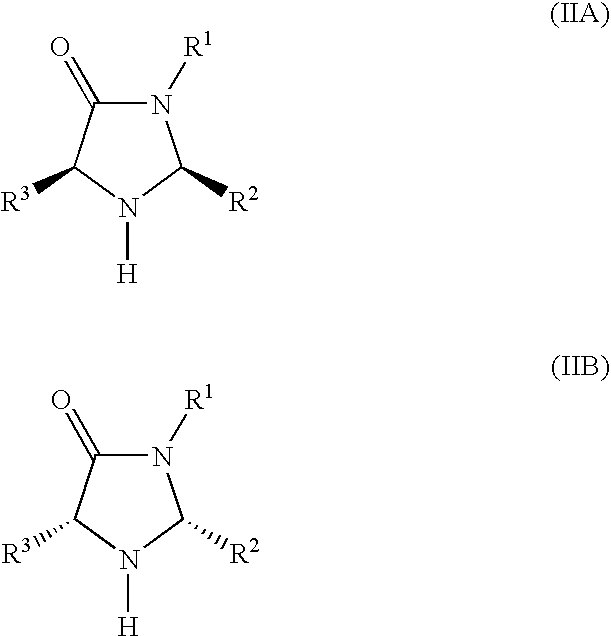Hydride reduction of alpha, beta-unsaturated carbonyl compounds using chiral organic catalysts
a technology of organic catalysts and carbonyl compounds, applied in the preparation of carbonyl compounds, organic compounds/hydrides/coordination complexes, physical/chemical process catalysts, etc., can solve the problems of inability to predict with reasonable accuracy, many organometallic reagents are expensive, and the catalytic activity of many compounds may not be commercially viable, so as to reduce the energy level of the lowest unoccupied molecular orbital and reduce the lumo of the compound
- Summary
- Abstract
- Description
- Claims
- Application Information
AI Technical Summary
Benefits of technology
Problems solved by technology
Method used
Image
Examples
example 1
[0090] This example describes the synthesis of a catalyst used in the method of the invention in two steps from phenylalanine methyl ester, according to the following scheme:
[0091] Preparation of the hydrochloride salt of (2S,5S)-5-benzyl-2-tert-butyl-3-methyllimidazolidin-4-one (1): To a solution of ethanolic MeNH2 (8.0 M, 50 ml) was added (S)-phenylalanine methyl ester (23.0 g, 130 mmol). The resulting solution was stirred at room temperature until the amino ester was judged to be consumed by TLC analysis. The resulting solution was then concentrated to provide (S)-phenylalanine N-methyl amide (18 g, 82% yield) as a white solid. To a flask containing (S)-phenylalanine N-methyl amide (8.9 g, 50 mmol) was added THF (100 ml), trimethylacetaldehyde (5.4 g, 50 mmol), FeCl3 (1.7 g, 10 mmol) and 4 Å MS (5.0 g). The resulting mixture was stirred at room temperature for 36 h, then washed with H2O (3×100 mL). The combined organics were concentrated and the resulting residue was treated wi...
example 2
[0094] Preparation of (E)-3-cyclohexylbut-2-en-1-ol: To a 0° C. solution of (E)-ethyl 3-cyclohexylbut-2-enoate (Appella et al. (1999), J. Am. Chem. Soc. 121:9473) (1 g, 5.09 mmol) in dry Et2O (10 mL) was added a solution of lithium aluminum hydride (5.10 mL, 5.10 mmol, 1 M in Et2O). After 5 minutes, the reaction mixture was neutralized by dropwise addition of THF solution followed by addition of a saturated solution of potassium sodium tartrate. The reaction mixture was stirred for 25 minutes, and then diluted with Et2O. The organic layer was separated and washed with water, dried over Na2SO4 and concentrated in vacuo to afford (E)-3-cyclohexylbut-2-en-1-ol as a colorless oil which was used directly in the following reaction.
example 3
[0095] Preparation of (E)-3-cyclohexylbut-2-enal: To a solution of (E)-3-cyclohexylbut-2-enol (700 mg, 4.54 mmol) in dichloromethane (11 mL), cooled to 0° C., was added Dess-Martin periodinane (2.11 g, 4.99 mmol). The resulting suspension was warmed to 23° C. and stirred for approximately 30 minutes until the reaction was judged to be complete by TLC. The reaction mixture was poured into 50 mL of saturated aqueous NaHCO3 containing Na2S2O3 (1 g). This mixture was stirred vigorously until both layers became clear. The aqueous layer was extracted with CH2Cl2 (2×) and the combined organic layers were dried over MgSO4, filtered and concentrated in vacuo. The residue was purified by flash chromatography (25% EtOAc / hexanes) to afford the title compound as a colorless oil (350 mg, 51% yield) that was a 5.2:1 mixture of E:Z isomers. Major isomer: IR (film) 2929, 2854, 1729, 1674, 1640, 1450, 1383, 1198, 1164, 894, 850, 522 cm−1; 1H NMR (300 MHz, CDCl3) δ 10.05 (d, 1H, J=7.9 Hz CHO), 5.90 (d...
PUM
| Property | Measurement | Unit |
|---|---|---|
| pKa | aaaaa | aaaaa |
| enantiomeric excess | aaaaa | aaaaa |
| enantiomeric excess | aaaaa | aaaaa |
Abstract
Description
Claims
Application Information
 Login to View More
Login to View More - R&D
- Intellectual Property
- Life Sciences
- Materials
- Tech Scout
- Unparalleled Data Quality
- Higher Quality Content
- 60% Fewer Hallucinations
Browse by: Latest US Patents, China's latest patents, Technical Efficacy Thesaurus, Application Domain, Technology Topic, Popular Technical Reports.
© 2025 PatSnap. All rights reserved.Legal|Privacy policy|Modern Slavery Act Transparency Statement|Sitemap|About US| Contact US: help@patsnap.com



